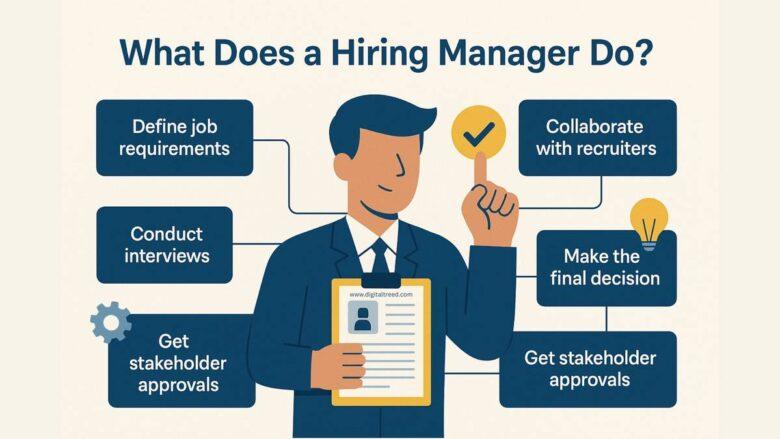Hiring managers wear a lot of hats—and no, it’s not just about conducting interviews. Their role spans the entire hiring process, from identifying the need for a new hire to making the final call. Sometimes, they even weigh in on whether the position should be opened to international applicants. And let’s be honest—hiring across borders isn’t exactly a walk in the park. It can be complex, messy, and a major time suck for HR teams.
But there’s a workaround for that. Many companies now use an Employer of Record (EOR) service like Remote. Think of it as hiring through a legal umbrella in another country. The EOR takes care of payroll, taxes, compliance, and HR paperwork so that neither the HR team nor the hiring manager has to drown in legal red tape. It really streamlines things and allows everyone to focus on onboarding the right person instead of worrying about international labor laws.
So, What Exactly Does a Hiring Manager Do?
Here’s a quick (but not exhaustive) rundown of their key responsibilities:
- Identifying the need for a new team member.
- Getting approvals from upper management.
- Writing or approving clear, honest, and appealing job descriptions.
- Deciding who’s involved in the hiring process.
- Keeping the hiring team on track and informed.
- Laying out how the interviews will be conducted.
- Acting as the main point of contact and lead interviewer.
- Interviewing candidates after initial screenings are done.
- Promoting the job internally and gathering referrals.
- Making the final hiring decision (though it usually still needs executive sign-off).
- Notifying recruiters if the job gets put on hold or cancelled.
- Writing up job offers and talking through contracts with selected candidates.
Sounds like a lot? That’s because it is.
Hiring Manager vs. Recruiter: Not the Same Thing
People often mix up recruiters and hiring managers. Sure, both are involved in hiring, but their roles are very different.
Recruiters are like talent scouts. Their main job is to find and pre-screen a solid group of qualified candidates. Hiring managers, on the other hand, select the right person from that group and ultimately decide who gets the job offer.
In a way, the recruiter is supposed to make the hiring manager’s job harder by presenting a pool full of amazing people. At the same time, they also prevent bad hires by doing their own filtering before anyone reaches the hiring manager’s desk.
Hiring managers also play a key role during salary and contract negotiations. If none of the candidates click, the manager tells the recruiter to go back to the drawing board and source a new batch.
Read Also: Amazon Human Resources Management: Complete Guide for 2025
Where Things Go Sideways Between Hiring Managers and Recruiters
It’s not always sunshine and rainbows. Sometimes, the relationship between the hiring manager and recruiter can get… tense.
Why? A few reasons:
The hiring manager isn’t impressed with the candidate pool.
They expect way too much from the recruiter.
They have conflicting ideas about how long the process should take or how to approach it.
Hiring managers are often in a rush. They want someone yesterday and may not want to wait for the full candidate list. Recruiters, meanwhile, want to do their job thoroughly—sourcing, screening, and shortlisting the best.
It’s up to the recruiter to push back a little and say, “Hey, let me do this right.” But on the flip side, hiring managers also need to accept they can’t (and shouldn’t) do it all alone. The best partnerships happen when both sides respect each other’s expertise.
Here’s how hiring managers can help things go more smoothly:
Don’t try to wing it alone—lean on the recruiter’s insights.
Set aside time to focus on recruitment (yes, it’s worth it).
Collaborate to make sure you’re both aligned on what the team really needs.
From Job Request to Job Offer: How the Process Flows
Everything starts when a hiring manager submits a formal job requisition. This is basically a detailed request to open a new position, often requiring sign-offs from higher-ups.
Once it’s approved, the recruiter jumps in and has a deep-dive meeting with the hiring manager. This is the intake stage, and it’s where they get all the juicy details to help attract the right candidates.
Some questions hiring managers should be ready to answer during this stage:
- What makes this job more attractive than similar roles at other companies?
- What does success look like in this position?
- What kind of impact will a great (or bad) hire have on the team and clients?
- What are the key qualities or benefits that would attract someone to this role?
- What kind of salary, hours, and benefits are we offering?
- Are we approaching this hire differently than we did last time?
- What personality traits or skill gaps do you want to fill in your current team?
The clearer the hiring manager is, the more accurately the recruiter can describe the role and find candidates who genuinely fit—not just on paper, but culturally too.
After the job ad goes live, the recruiter starts working their magic—posting, sourcing, and screening. Once they have a shortlist of solid candidates, the hiring manager steps in for interviews and makes the final call. Then comes the job offer, and if all goes well, onboarding begins.
Read Also: Span of Control Isn’t One-Size-Fits-All (Here’s What to Do Instead)
The “People” Side of a Hiring Manager’s Role
Beyond the logistics and paperwork, hiring managers have some very human responsibilities too. These often get overlooked, but they’re just as important:
1. Hiring for Team Fit, Not Just Skills
Gone are the days of hiring the “perfect” candidate based on a checklist. These days, a smart hiring manager looks at how a person fits into the team dynamic. Does this candidate bring a skill or perspective the team is missing? Do they complement the team’s vibe and work style? Diversity in thought and strengths matters.
2. Planning for Growth and Development
It’s also part of the hiring manager’s job to think about long-term development. Where is the team heading, and what kind of learning or training does each member need to get there? A clear development path can be a game-changer for attracting great candidates.
3. Coaching, Not Commanding
Today’s managers aren’t drill sergeants. They’re more like coaches—guiding their people, encouraging them, and helping them grow both personally and professionally. A good hiring manager knows when to push, when to pull, and when to just listen.
4. Prioritizing Well-Being
Especially after COVID, keeping an eye on employees’ mental and physical health has become part of the job. This is even trickier with remote teams. Managers have to watch for signs of burnout, disconnection, or low morale. It’s not always obvious, but it’s critical.
And here’s the thing—these “soft” factors do influence hiring. When a company has a strong reputation for caring about its people, it attracts better talent. Word gets around.
What Hiring Managers Are Actually Looking For
Everyone says hiring managers are looking for “fit”—but what does that even mean?
It’s not just about culture or whether someone is a team player. It’s about alignment—does the candidate seem genuinely excited about the role and the company? Do their values, goals, and work style match what the team needs?
Here are a few specific things hiring managers pay close attention to:
Cultural Understanding
Candidates who take time to research the company’s values and vibe tend to stand out. Is the workplace formal or relaxed? In-office or remote-first? These things matter.
Preparedness
The candidates who show up knowing about the company—and ask smart, thoughtful questions—come across as more invested.
Relevant Experience
It’s not just about listing your past jobs. Great candidates explain how their previous roles prepared them for this one. They give real examples, not just buzzwords.
Wrapping It Up
A hiring manager’s job doesn’t end when the offer letter goes out—it actually just begins. They’re responsible for making sure the new hire is a good fit not only for the job but for the team and the company as a whole.
The best hiring managers? They partner closely with recruiters, communicate clearly, and care deeply about building strong, cohesive teams—not just checking boxes. In the end, it’s not about filling a role; it’s about creating a workplace where people thrive.





Leave a Reply
View Comments